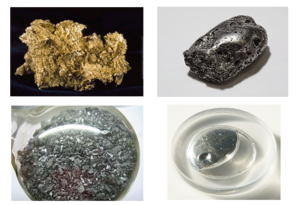
Whatever the place or size occupies in the classical scientific perspective, and shows the body of materiality (or mass) and gravitational, it is called substance.
In chemistry, the substances are divided into two categories: basic substances (which can not be analyzed in chemical compositions in simpler elements) and composite materials (which can be chemically analyzed in simplest elements as well as basic matter). Basic substances constitute composite materials by chemical reactions with each other. So far, more than one hundred elements have been identified. The basic materials are divided into categories such as metals, metals, metals, etc. Both basic and composite materials reliably demonstrate specific physical and chemical beliefs. Pure basic or composite materials are not usually available in nature. They generally exist as homogeneous or non-identical mixed substances; Mixed substances have no specific chemical chemicals. In addition, the carbon name of the Earth in the form of hydrogen, oxygen, nitrogen, sulfur and phosphorous have formed a large number of organic compounds that are produced by the foundation or organism of life.
In the theory of modern particle physics, the substance is assumed to be a large number of molecules and atoms. Atoms are the smallest units that exhibit the chemical formula of the basic substance. Inside the atom there is an atomic or nucleus composed of proton and non-proton neutron particles and a "cloud" of negative particles of "rotational" surrounding it determines the "occupied space" of the atom. [3] [4] The interior of the atom The number of proton particles determines the chemical properties of a basic substance. The atoms form a stable basic or composite molecule, interconnected with chemical composition of electromagnetic, computational, insertion, metallic, etc. Molecules again combine each other with different types of intraocular attraction balls, creating sensory or observable gross substances in the laboratory, which can be present in different conditions or states (hard, liquid, gaseous, etc.).
According to classical physics, power (the ability to perform substance or to produce heat) and substances are two separate entities which together form the foundation of all physical physical phenomena. But according to modern physics (special relativity) matter and energy are transformable in one another, so these are two different forms of the same entity. However, in the interest of giving a simple interpretation of many other things including speed, fluid and aerobics, heat, etc., scientists consider the substances and the forces as two separate entities.
One of the main elements that constitute the visible objects of all the physical objects, known as the known universe. It is also called the common substance. However, a majority of the universe (about 95%) is made up of unknown ingredients called Tomato and Hemophilia, whose nature is still not known very much.
Scientists also believe that theoretically, the universe has the same substance and substance. The particles of the substance actually expose each other in contact with the particles of matter. But the substance is very rare in the observable universe. This absence of substance or rareness is a major disenfilled problem of current physics.
Thank you for read this post.Follow me to get more information about science.If you have any question about science, ask in the comment box.I will try to give answer your question.Join my discord server.Sign up on WEKU.Here is the weku referral link.